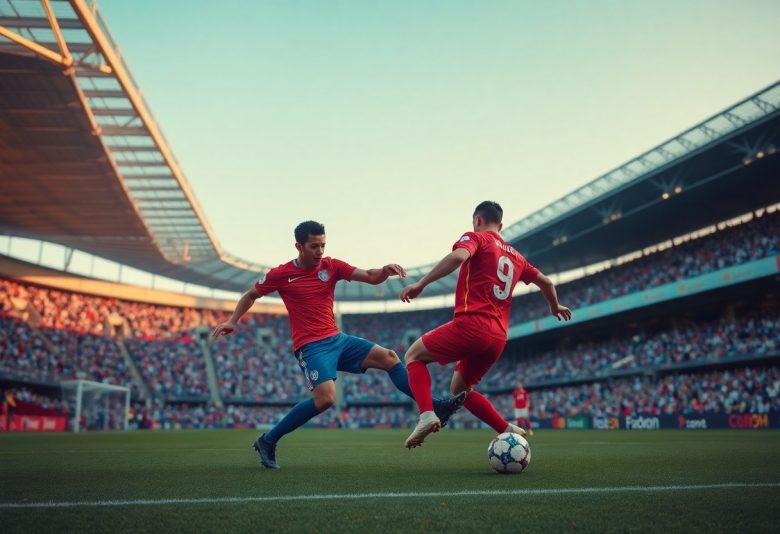Most fans focus on the flashy forwards and creative midfielders, but the role of the left-back is equally important on the pitch. These players are the backbone of any strong defense, skillfully balancing the responsibilities of thwarting opposition attacks while supporting their team’s offensive play. In this blog post, you will discover the best left-backs in football history, highlighting their skills, contributions, and why they deserve your admiration as the unsung heroes of the game.
The Role of a Left-Back in Modern Football
A left-back is no longer just a defensive player. In modern football, your left-back must balance defensive duties with offensive responsibilities, contributing effectively to both phases of play. You’ll find that they often push forward to support attacks, creating width and providing imperative passes or crosses into the box. This dual role makes the left-back a vital cog in your team’s tactical setup, showcasing the evolution of the position in today’s game.
Defensive Responsibilities
Before you step onto the pitch, it’s imperative to understand that a left-back’s primary role is to defend the space on the left flank. This means marking opposing wingers, blocking crosses, and making crucial tackles. You are expected to maintain positional discipline, ensuring your team remains organized while also being able to cover central defenders when they are drawn out of position. Your awareness and quick decision-making play a significant role in protecting your goal.
Offensive Contributions
One of the exciting aspects of being a left-back today is your opportunity to contribute offensively. You’re not just a defender; you’re an important attacking option. You can overlap with wingers, provide width, and deliver quality crosses into the box, helping create scoring opportunities for your team.
Contributions made by a left-back often extend beyond mere assisting; they can also initiate offensive plays through well-timed runs and strategic positioning. By offering support to midfielders and forwards, you not only enhance your team’s attacking dynamics but also keep the opponent’s defense on its toes. Your ability to transition quickly from defense to attack can be a game-changer, making overlaps and darting runs crucial for maintaining pressure on opposing teams. This balance between your defensive and offensive roles is what makes you an imperative asset to your squad.
Top Ranked Left-Backs of All Time
Even though left-backs often play in the shadows of glitzy forwards, their contributions to the game’s strategy are irreplaceable. The best left-backs have the agility to attack and the awareness to defend, making them central to their team’s success. From historic legends to today’s stars, these players have left an indelible mark on football history.
Legendary Left-Backs
One of the standout figures in football history is Paolo Maldini, whose unparalleled defensive skills and leadership transformed the left-back position into a pivotal role in any team. Alongside him, the likes of Roberto Carlos and Franco Baresi have set standards for future generations, showcasing the impact that quality left-backs bring to the game.
Contemporary Greats
At present, the landscape of left-back talent is as vibrant as ever, with several players setting new benchmarks for performance. Stars like Andrew Robertson and Ben Chilwell blend exceptional speed and technique, demonstrating that modern left-backs continue to evolve in their roles.
For instance, Andrew Robertson’s relentless work rate and ability to contribute to both defense and attack have made him an indispensable asset for Liverpool, while Ben Chilwell’s versatility and tactical awareness allow him to fit seamlessly into various styles of play. These contemporary greats not only defend but also transition play, reflecting how the left-back role has transformed in recent years, requiring a balance of skill sets that keep you intrigued by their every move on the pitch.
Key Attributes of an Elite Left-Back
Some might underestimate the impact of a left-back on the game, but these players are imperative to both defense and attack. An elite left-back possesses a unique blend of skills that allows them to support their team effectively while maintaining solid defensive integrity. This chapter will investigate into the specific attributes that define top-tier left-backs, highlighting what you should look for in these unsung heroes of the pitch.
Technical Skills
With a mastery of imperative technical skills, an elite left-back can excel in various game situations. Proficient passing, precise dribbling, and exceptional crossing abilities are vital for transitioning from defense to offense. Your left-back should be capable of executing accurate long balls to switch play or deliver dangerous crosses into the box, creating scoring opportunities for forwards.
Tactical Awareness
Around the pitch, tactical awareness is fundamental for a left-back’s success. Understanding positioning and the ability to read the game enables you to anticipate threats, maintain defensive shape, and provide support to teammates. It is important for a left-back to recognize when to push forward and when to fall back, ensuring the team remains balanced during transitions.
To enhance your understanding of tactical awareness, consider how an elite left-back reads the opponent’s movements and their own team’s formation. A strong sense of spatial awareness allows for effective communication with central defenders and midfielders, creating a unified wall against opposing attacks. Moreover, you should appreciate the left-back’s role in initiating counter-attacks, bolstering attack while also maintaining defensive responsibilities. This duality is what defines a top left-back in modern football.
Impact of Left-Backs on Team Success
All great teams recognize the significance of their left-backs. These players contribute not only in defense but also in creating opportunities on the attack. A solid left-back can be the linchpin, providing balance and support to the team, which ultimately enhances overall performance. When you understand the impact of these players, you’ll appreciate how a well-performing left-back can lead your team to success.
Case Studies
On analyzing the contributions of various left-backs throughout football history, you can see their linkage to team achievements. Here are some noteworthy cases:
- Roberto Carlos – Helped Brazil win the 2002 World Cup, contributing 2 assists and 1 goal during the tournament.
- Marcelo – Vital in Real Madrid’s Champions League victories (2016, 2017, 2018), registering 4 assists across those finals.
- Andrew Robertson – Key to Liverpool’s Premier League and Champions League triumphs in 2020, providing 12 assists that season.
- Alphonso Davies – Integral in Bayern Munich’s 2020 Champions League victory, noted for his speed, registering 4 assists in the tournament.
Statistical Analysis
An in-depth examination of left-backs reveals just how influential they can be in a team’s performance metrics. For instance, teams with effective left-backs often see a 20% increase in successful attacking plays and a significant reduction in defensive errors. This data demonstrates that investing in a dynamic left-back not only strengthens your defense but enhances overall strategy by providing offensive support. Understanding these statistics will allow you to better appreciate the role of left-backs in your team’s journey toward triumph.
Emerging Talents in the Left-Back Position
Many fans overlook the importance of left-backs, yet emerging talents are gradually making waves in this often underappreciated role. As the modern game evolves, you’ll find fresh faces in the position, combining flair and defensive acumen. These young players not only provide stability but also add attacking options, showcasing the diverse skill sets necessary for the left-back role. Keep an eye on these budding stars on your favorite teams, as they may soon become household names.
Youth Prospects
Across various youth academies, exciting left-back prospects are honing their skills, ready to make their mark on the senior stage. Clubs are investing in training young talent, ensuring they develop into well-rounded players. You might be hearing whispers about these future stars, as many are already drawing the attention of scouts and fans alike. Their potential to blend defensive responsibilities with offensive contributions is something to watch closely.
Rising Stars in Major Leagues
Prospects in major leagues are beginning to showcase their talent, demonstrating that left-backs can be game-changers. You may find that these players not only defend effectively but also contribute to their teams’ offensive play, pushing forward and creating chances. Their confidence and skill on the field are reshaping the expectations for the left-back position.
The excitement surrounding these rising stars is palpable as they begin to gain recognition not just for their defensive capabilities, but also for their ability to impact the game. You’ll likely see them make headlines in their respective leagues, turning heads with fantastic assists and impressive runs down the flank. Players like these highlight the evolution of the left-back role, proving you don’t have to be in the spotlight to make waves in football.

The Future of the Left-Back Role
For every evolution in football tactics, the left-back position morphs to meet new demands. As teams increasingly prioritize attacking fluidity, you’ll find that modern left-backs must not only defend but also provide width and support in the offensive phase. This shift heralds an exciting future for the role, where adaptability and versatility will be paramount in shaping the next generation of left-back talents.
Evolution of Playstyles
Below the surface of tactical shifts, the philosophy of playstyles has significantly impacted how left-backs perform. You’ll notice that teams are now embracing fluid formations, allowing left-backs more freedom to express themselves while contributing to both defensive and offensive play. These changes foster a new breed of defenders skilled in dribbling, passing, and quick decision-making.
How Tactical Trends are Shaping Left-Backs
Against this backdrop, the tactical trends of pressing and positional play are redefining the responsibilities of left-backs. You will observe an increasing demand for these players to effectively transition between defensive and attacking roles, often acting as a bridge in various phases of play.
In fact, as football evolves, you see left-backs becoming integral to counter-attacks and build-up play, often pushing high up the pitch to create opportunities. Their need to be technically proficient while also understanding defensive responsibilities has led to a richer skill set. As a result, future left-backs will likely have backgrounds in youth systems that emphasize these dual roles, ensuring they are fully equipped to thrive in an increasingly dynamic environment. You can expect this trend to continue as tactical innovations further challenge and refine the left-back position.
Conclusion
From above, it’s clear that the best left-backs in football play a pivotal role that often goes unnoticed. By understanding their contributions, you can appreciate how these unsung heroes stabilize defenses while also initiating plays that lead to goals. Whether it’s through their tireless running, strategic positioning, or ability to read the game, recognizing the impact of these players enriches your overall view of the sport. Embrace the vital functions of left-backs in your analysis of football’s tapestry, as they exemplify the blend of skill, athleticism, and teamwork important for success.




